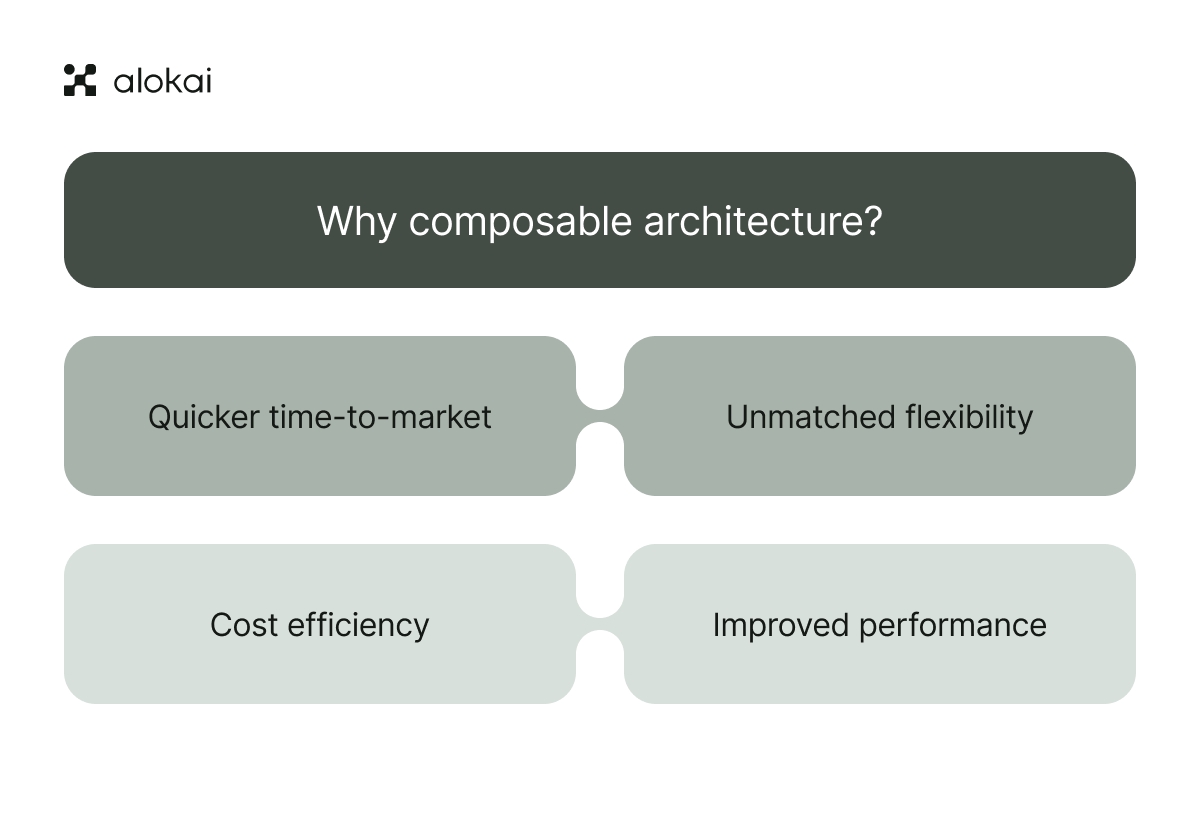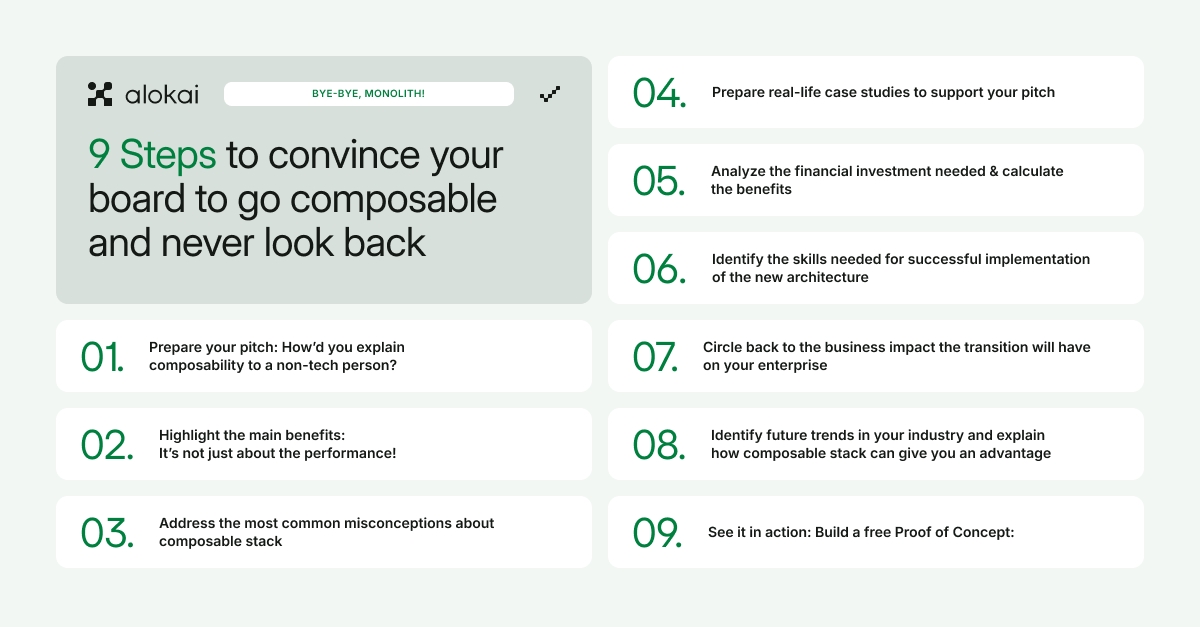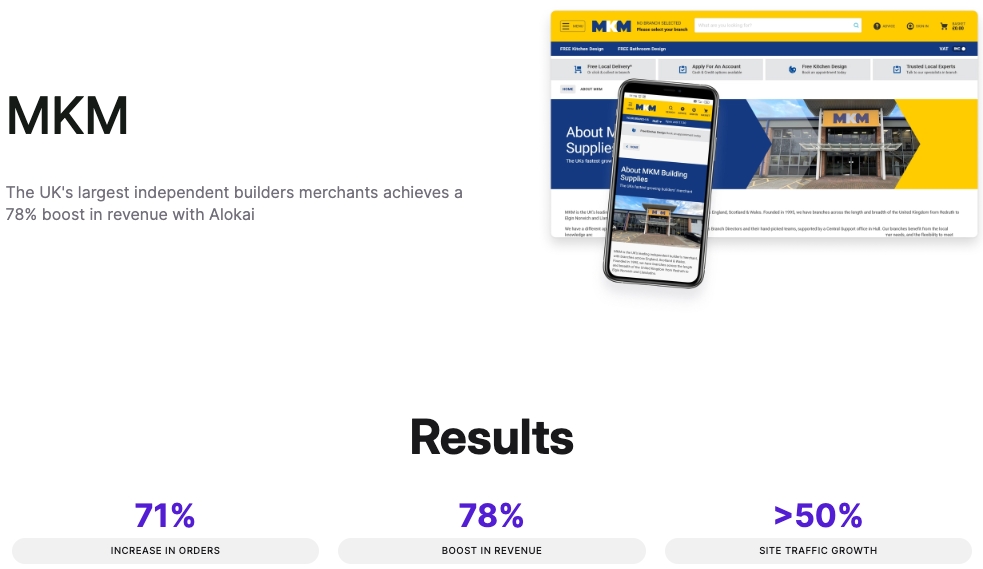Shifting from a monolithic system to a composable architecture is a big decision, but it’s one that could redefine your company’s future. While the board may have reservations, with the right approach, you can help them see the transformative potential of this move.
Here’s how to make your case effectively.
This article is based on a recent webinar hosted by Alokai and Brave Bison on the topic of “Get your board on board: How to build a business case for composable?”. View the full recording here.
Why composable architecture?
Let’s consider why composable architecture isn’t just a fleeting trend—it’s a forward-thinking strategy that positions your company for long-term success. Here’s what to highlight when talking to decision-makers in your company.

Unmatched flexibility and scalability
Composable architecture breaks down your system into independent, reusable components. This modular approach can help your teams work more efficiently, eliminating the challenges that often arise in monolithic systems. By enabling faster development cycles, the composable architecture supports quicker scaling and more agile responses to market demands.
Quick time-to-market
In a fast-moving market, the ability to respond quickly can make all the difference. Composable commerce enables you to deploy features iteratively, which allows your company to meet customer needs in real-time. This agility becomes a significant competitive advantage, as it promotes faster innovation and adaption compared to companies still relying on monolithic systems.
Cost efficiency that pays off
Yes, the upfront investment in composable architecture can seem high, but the long-term savings are more than worth it.
By reducing development time and lowering maintenance costs, you’ll likely see a strong return on investment. Plus, since you’re only integrating the components you need, your spending is more targeted and efficient, avoiding the waste that often comes with monolithic systems.
Performance that drives results
Composable architecture allows you to choose the best tools for each aspect of your system, ensuring that your technology aligns closely with your business goals. This focus on best-of-breed solutions can significantly enhance system performance, which in turn drives better outcomes for your business.
There are far fewer blockers from a dev perspective. That reduces the development time and cost, and you can maintain it more easily because you can identify where issues are and what's happening. That allows you to adapt faster to new trends.
- Buster Dover, Brave Bison
So, what should you take to the board to seal the deal and embrace composability?
Addressing board concerns: A comprehensive checklist
When it comes to actually convincing your board, you need to be prepared. Anticipate their concerns, and be ready to address them head-on.

1.Craft a clear and compelling pitch
Explain the concept in clear, compelling terms that resonate with the company’s business goals. Avoid tech jargon and focus on the strategic advantages.
This is more than a tech upgrade; it’s a strategic move towards greater agility and competitive advantage.
2. Bust the myths
One very common myth about composable architecture is that it’s just performance enhancement, but composable is much more than that. It’s about achieving better integrations, improving customer satisfaction, and ultimately better ROI as a result.
Make sure the board understands that this transformation impacts every aspect of the business, but it doesn’t need to be a full-on revolution: migration can happen gradually, and you won’t need to abandon all legacy systems.
3. Evaluate the skillset required
Implementing composable architecture does require a certain level of expertise.
Evaluate whether your in-house team has the necessary experience with API design, CICD, microservices, and so on. If there are gaps, consider whether it makes more sense to hire externally or invest in upskilling your existing team.
4. Show the money
Break down the financials. Yes, there’s an initial investment, but the long-term benefits will dwarf those costs.
Reduced development time, lower maintenance expenses, and a higher Average Order Value (AOV) will all have a strong impact on ROI. Make sure your board sees the big picture—this is an investment that will pay off in the long run!
5. Address SEO concerns
Transitioning to a single-page application within a composable architecture can impact SEO, which might cause concerns. It’s important to explain that, with the right strategy and technical SEO team in place, these risks can be managed effectively.
Make it clear that the benefits of improved performance will ultimately outweigh any potential SEO challenges.
7. Position composable as a strategic advantage
Show composable architecture as the key to staying ahead of the curve; it’s what you need to future-proof the company.
By freeing up resources for innovation and enabling faster adaptation to market changes, this approach supports long-term growth and success.
8. Align with business goals
Tie everything back to your company’s broader business objectives. Composable architecture isn’t just a tech upgrade—it’s a move that supports scaling, global rollouts, and improved sales efficiency.
Make sure the board understands that this is about driving business success, not just tinkering with technology.
9. Prove it with a PoC
You can show numbers and charts, but nothing can convince like success you can see and touch.
Offer to build a quick Proof of Concept (PoC) to showcase the benefits of composable architecture. Let C-level see firsthand how the new system will work, and watch their doubts melt away!
10. Seal the deal!
Convincing the board to go composable is all about presenting a clear, compelling case that aligns with their business goals.
With the right approach, you can make them see that composable architecture isn’t just the future—it’s the smart move for today.
Connect with Alokai to schedule a free personalized demo to learn how to tackle the move to composable














